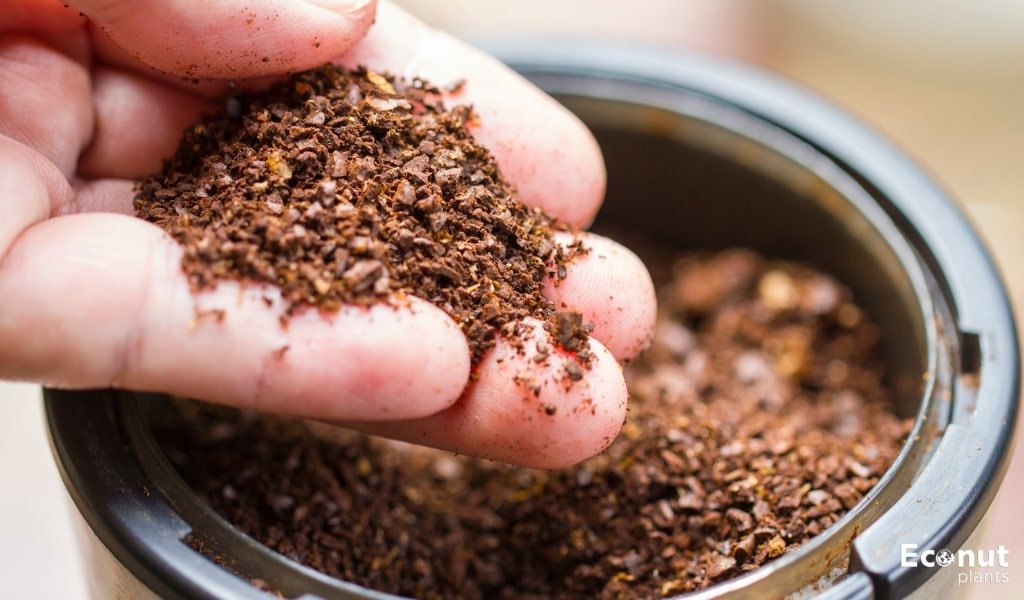Composting Coffee Grounds are an excellent source of organic ingredients for your plants. You can add ground coffee directly to the soil or compost it to enhance soil quality and deter pests in the garden.
Among other anecdotal benefits, coffee grinds make excellent mulch and fertilizer. These recommendations haven’t always produced the desired outcomes, though. Here are our best recommendations for using coffee grinds in your garden.
Which Plants Are Coffee Grounds Good For?
Soil pH affects plant health, although various plants need different pH levels. Most plants grow best in soil that is slightly acidic to neutral in pH, while some prefer acidic or alkaline soil. Consequently, it is not a good idea to haphazardly sprinkle coffee grinds on all of your plants.
Despite this, fresh coffee grounds retain most of their caffeine content. A plant’s preferred pH level indicates whether or not it will benefit from coffee grinds.
- Alkaline soils are ideal for sweet-tooth plants. Coffee grounds usually don’t do much for these plants unless you rinse them first to remove any extra acid. Many perennial plants, such as sedum, aloe, hostas, geraniums, and daylilies, prefer alkaline soil.
- Plants growing in acidic soil need a pH of less than 7.0. This list includes various plants, including trees, groundcovers, shrubs, and blooming perennials. Acid-loving plants include hydrangeas, magnolia trees, hollies, and azaleas. Popular edibles include tomatoes and blueberries above all others.
- Plants for natural soil are happiest when the pH is around 7.0. Almost all plants can grow in either acidic or alkaline soil, so pH isn’t often the primary criterion for “neutral” soil on plant requirements lists. Along with the majority of other garden plants, this group also contains asparagus and ferns.
Coffee Grounds in Compost
The addition of coffee grounds and used paper filters to your compost increases its nitrogen content, which is a key component that promotes composting growth. Green products are those that include nitrogen. Your coffee grounds may look brown, but when it comes to compost, they are green.
When adding brown items to the compost, like newspaper and dry leaves, add coffee grinds. Add coffee grounds to your compost only when cool, because heat might kill beneficial microbes.
Coffee Grounds as Fertilizer
You may either sprinkle the ground coffee grounds on top of the soil or rake them into the top few inches of the soil to add the composted coffee grounds to your garden soil.
Coffee grounds can reduce germination rates and growth; hence, they should not be used in environments where plants are being grown from seed. Instead, make sure the coating is no thicker than 1/2 inch.
Avoid using too many coffee grounds at once, though. The best technique to improve garden soil is to gradually add coffee grounds, but they can also help with drainage and aeration.
For yard and container plants, you can use this mixture as a liquid fertilizer. It is an excellent foliar feed that you may apply directly to the leaves and stems of your plants.
Also Read: Coffee Grounds Hydrangeas
Tips to Use Coffee Grounds
There are more uses for coffee grounds than just adding them to your compost or using them as a soil amendment.
- Prevent bugs and pests: Coffee grounds work well to repel slugs and snails, as well as wasps, fleas, and mosquitoes. You can use the coffee grounds just as they are without having to burn them before you spread them around your garden.
- Prevent pathogenic fungi: The growth of pathogenic fungi is inhibited by pin moulds, Fusarium, Pseudomonas, and other bacterial and fungal species that are typically found on decomposing coffee grounds.
Possible Disadvantages of Coffee Grounds for Plants
Using spent coffee grounds to grow broccoli, leeks, radish, viola, and sunflowers resulted in poorer growth in all soil types, regardless of the application of additional fertilizer.
The good news is that the coffee grinds enhanced the soil’s ability to retain water and inhibited weed development. You could wish to conduct your trials in your garden, both with and without coffee grinds, if you’re not getting the desired results from utilizing them.
FAQ
When is the right time to give plants coffee grinds?
The amount is more important than the frequency. If you add more coffee grinds than a thin covering around your plants, the soil will become impermeable, and water will not be able to penetrate. If you disperse coffee grinds evenly among the plants once a week, everything should be alright.
What kinds of plants dislike coffee grinds?
Coffee grounds can cause the soil to tilt towards acidity, which can negatively impact some plants, especially those that like soil that is somewhat alkaline, such as salvia, roses, and chrysanthemums. Before adding coffee grounds, find out which plants prefer this pH of soil by researching their preferences.
Can you fertilize potted plants with coffee grounds?
Yes, you can, but it should just be a light dusting. A thick layer of water-resistant coffee grinds can accumulate on top of the potting soil if you add too much. Watering your potted plants with leftover coffee is a far better idea, at least occasionally.

